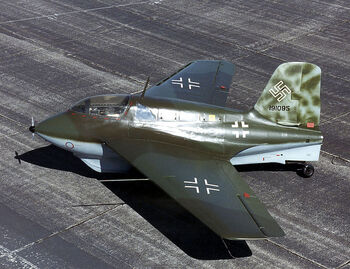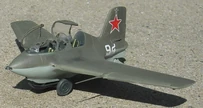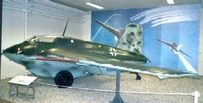
The 'komet'.
The Messerschmitt Me 163 "Komet" was a German World War II Interceptor aircraft by Messerschmitt. It was the first and the only operational rocket powered military aircraft.
The Me 163 was called a "Wunderwaffe", designed to help Germany win the War. It was a lousy plane to fly. It was the first aircraft capable of flying faster than 1000 km/h, with the Me 163A V4, piloted by glider champion Henri Dittmar, reaching 1003.67 km/h on 2nd October 1941. The top speed of the Me 163B V18 was 1130 km/h and was topped in 1953 by the Hawker Hunter F Mk3 with a maximum speed of 1171 km/h.
Development[]
The roots of the Me 163 went back to the 1920s, with Dr Alex Lippisch's aerodynamics, which adopted a tailless configuration to reduce weight and drag, and the various rocket research projects, leading to the Hellmuth Walter development from 1936 of engines suitable for manned aircraft, with nothing remotely similar being attempted in any country except the Soviet Union. Early research was centred at the DFS (German sail-plane research institute), where the first tailless rocket aircraft, the DFS 194, was planned. Completed in March 1938, the design was transferred to Messerschmitt in January 1939, shortly before the Walter R I-203 rocket flew - with poor results - in the He 176 research aircraft.[1]
Fitting a similar engine in a DFS 194 resulted in speeds of 342mph (550km/h). Sanction for a rocket engine was swiftly gained, leading to gliding trials using the Me 163 V1 in Spring 1941. In July-September 1941 Henri Dittmar pushed the speed under rocket power higher and higher, exceeding the offical world speed record.[2]
Despite the exemplary flight characteristics, the Me 163 was not without it's problems. There was a large element of danger due to the use of rocket propellants which violently reacted when they came into contact.[1] In addition, the lack of space for a standard landing gear necessitated the use of a jettisonable trolley and retractable skid combination, requiring great care on take off, because a pilot had to take off directly into the wind, and landing, as an imprecise touchdown could result in detonation of residual propellant.[3]
The final development was the Me 163C, with a longer body containing retractable undercarriage, increased span centre section and a new engine with a small chamber for cruising flight.[3]
Operational usage[]
The main operational version was the Me 163B. This was a short range point interceptor, equipped with a pair of 30mm Mk 108 cannon, each with 60 rounds. Power was provided by a single Walter 109.509 bi fuel rocket engine located in the tail. The fuel supply consisted of 226 Imperial Gallons of T-Stoff (concentrated Hydrogen-Peroxide) and 110 Imperial Gallons of C-Stoff (Hydrazine-Hydrate in Methonol)[4]
Gallery[]
References[]
Bibliography[]
- Gunston, Bill. Illustrated Directory of Fighting Aircraft of World War II. Salamander. 1988. ISBN 0-86101-390-5
- Bridgeman, Leonard. Jane's Fighting Aircraft of World War II (Reprint of Jane's All The World's Aircraft 1945/46). Tiger Books. 1998. ISBN 1-85501-996-5








